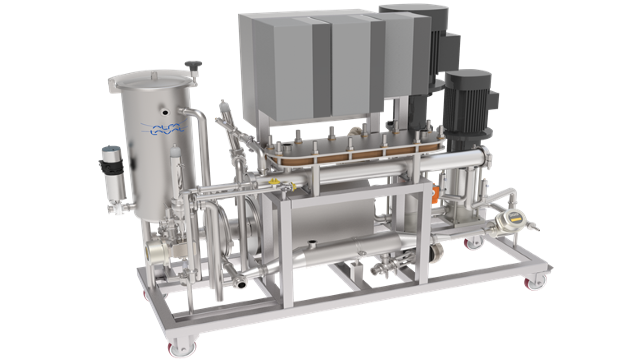Frittstående pilotanlegg
Alfa Laval offers a wide range of small-scale units and pilot plants which are ideal for on-site testing. Valuable data is gained for evaluation of process feasibility, determination of design and up-scaling, optimization of existing production lines or processing of high-value products
Small-scale units and pilot plants
In order to ensure the optimum solution, it is often advisable to conduct experiments on a small scale. These can be used to establish process feasibility, determine design data for up-scaling, optimize existing production lines or even carry out small-scale processing of high-value and/or low-volume products.
Our range of small-scale units and pilot plants is based on the unique plate-and-frame modules or the full-fit sanitary spiral elements, or a combination of both. The sizes vary from only a few litres of test media volume in the Alfa Laval LabUnits up to 1,000 litres in the Alfa Laval PilotUnits. it is possible to test all filtration processes: Reverse osmosis, nanofitration, ultrafiltration and microfiltration.
On-site testing or at Alfa Laval pilot facilities
Alfa Laval provides small-scale modules, units and pilot plants for testing on-site in connection with other process equipment and for testing at our own state-of-the-art Membrane and Application Development Test Centre in Nakskov, Denmark. In both cases, we also provide highly skilled process consultancy services.
Benefits
- You can make the first screening evaluations in your own laboratory and thus get the correct answers to vital questions
- The same design is used for both small-scale and industrial scale equipment which allows you to develop new processes and products
- The data gathered is accurate and reliable for easy up-scaling
- Alfa Laval has its own membrane and application development test centre where experts are ready to help you with process know-how and test work
- You can conduct experiments with both plate-and-frame and spiral wound module configurations - and all filtration processes
Hvordan fungerer membranfiltrering
Fysisk separasjon
Membranfiltrering er en fysisk separasjonsprosess der drivkraften er forskjellen i trykk mellom de to sidene av en spesiell membran. Denne prosessen er preget av evnen til å skille molekyler av forskjellige størrelser og egenskaper.
Nesten all industriell membranfiltrering utføres som cross-flow-filtrering, hvor væsken som filtreres, strømmer parallelt med membranen med høy hastighet og under trykk.
Fysisk barriere
I sine mest grunnleggende termer innebærer membranfiltrering å føre en enkelt matestrøm gjennom et membransystem som skiller den i to individuelle strømmer, kjent som permeatet og retentatet. Membranen som skiller dem er en fysisk barriere med høyt spesialiserte egenskaper – en barriere som kun enkelte utvalgte komponenter i tilførselsstrømmen kan passere gjennom.
Passerer gjennom
Porene i et slikt membranmateriale er så små at de måles i ångstrøm (10–10 m), og det kreves trykk for å tvinge væsken gjennom dem. Faktisk er porene i membranene som brukes til nanofiltrering og omvendt osmose, så små at de ikke kan sees selv med et skanningselektronmikroskop.
Long experience with membranes
Alfa Laval's experience within membrane filtration dates back almost as far as the technology itself, and we wish to share our experience with you.

